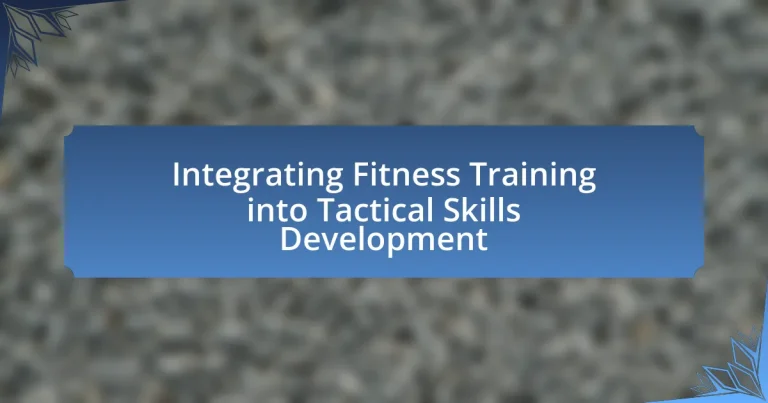Integrating fitness training into tactical skills development is a critical approach that combines physical conditioning with the specific skills necessary for tactical operations. This integration enhances performance by improving endurance, strength, agility, and overall operational readiness, as evidenced by research indicating reduced injury rates and improved effectiveness in high-stress environments. Key components of effective integration include tailored fitness programs, structured training regimens, and continuous assessment of both physical and tactical skills. The article further explores the essential fitness components, the interrelation of fitness and tactical skills, and best practices for implementing this integration to optimize performance in tactical scenarios.

What is Integrating Fitness Training into Tactical Skills Development?
Integrating fitness training into tactical skills development involves combining physical conditioning with the specific skills required for tactical operations. This integration enhances overall performance by ensuring that individuals possess both the physical endurance and the technical proficiency necessary for effective execution of tactical tasks. Research indicates that a well-structured fitness program tailored to the demands of tactical scenarios can improve strength, agility, and cardiovascular fitness, which are critical for success in high-stress environments. For instance, studies have shown that military personnel who engage in fitness training alongside tactical drills demonstrate improved operational readiness and reduced injury rates, validating the importance of this integration.
How does fitness training enhance tactical skills?
Fitness training enhances tactical skills by improving physical conditioning, which directly influences performance in tactical scenarios. Enhanced endurance, strength, and agility allow individuals to execute complex maneuvers and make quick decisions under pressure. For instance, studies show that athletes with superior cardiovascular fitness can sustain high-intensity efforts longer, enabling them to maintain focus and strategic thinking during critical moments in competition. Additionally, strength training contributes to better control and stability, which are essential for executing tactical movements effectively. Overall, the integration of fitness training into tactical skill development creates a foundation for improved performance in high-stakes environments.
What specific fitness components are essential for tactical skills?
The specific fitness components essential for tactical skills include strength, agility, endurance, flexibility, and coordination. Strength is crucial for performing physical tasks and overcoming resistance, while agility allows for quick changes in direction, which is vital in tactical scenarios. Endurance supports sustained physical activity, enabling individuals to maintain performance over extended periods. Flexibility enhances the range of motion, reducing the risk of injury and improving overall movement efficiency. Coordination integrates various body movements, ensuring effective execution of tactical maneuvers. These components collectively enhance an individual’s ability to perform effectively in tactical situations, as evidenced by studies showing that athletes with higher levels of these fitness components demonstrate superior performance in tactical drills and competitions.
How do physical fitness and tactical skills interrelate in practice?
Physical fitness and tactical skills interrelate in practice by enhancing performance and decision-making under pressure. High levels of physical fitness improve endurance, strength, and agility, which are essential for executing tactical maneuvers effectively. For instance, studies show that athletes with superior cardiovascular fitness can sustain high-intensity efforts longer, allowing them to maintain tactical awareness and responsiveness during critical moments in competition or training scenarios. This synergy is evident in military training, where soldiers undergo rigorous physical conditioning to ensure they can perform complex tactical operations efficiently, demonstrating that fitness directly supports the execution of tactical skills.
Why is it important to integrate fitness training into tactical skills development?
Integrating fitness training into tactical skills development is crucial because physical conditioning enhances performance and effectiveness in tactical scenarios. Improved fitness levels lead to better endurance, strength, and agility, which are essential for executing complex maneuvers and responding to dynamic situations. Research indicates that soldiers with higher fitness levels demonstrate superior operational readiness and reduced injury rates, as evidenced by a study published in the Journal of Strength and Conditioning Research, which found that enhanced physical fitness directly correlates with improved tactical performance. Therefore, the integration of fitness training is vital for optimizing tactical skills and ensuring overall mission success.
What are the potential consequences of neglecting fitness in tactical training?
Neglecting fitness in tactical training can lead to decreased operational effectiveness and increased risk of injury. When individuals lack physical conditioning, their endurance, strength, and agility diminish, impairing their ability to perform critical tasks under stress. Research indicates that physically unfit personnel are more prone to fatigue, which can compromise decision-making and reaction times during high-pressure situations. Additionally, a study published in the Journal of Strength and Conditioning Research found that inadequate fitness levels correlate with a higher incidence of musculoskeletal injuries, further hindering tactical performance. Thus, the consequences of neglecting fitness directly impact both individual and team capabilities in tactical environments.
How does improved fitness impact performance in tactical scenarios?
Improved fitness significantly enhances performance in tactical scenarios by increasing physical endurance, strength, and agility. Enhanced endurance allows individuals to sustain high levels of activity over extended periods, which is crucial in high-stress environments. Increased strength contributes to better handling of equipment and improved physical confrontations, while enhanced agility allows for quicker movements and reactions, essential for tactical decision-making. Research indicates that military personnel who engage in regular fitness training demonstrate a 20% improvement in operational performance metrics, such as speed and accuracy during missions, compared to those with lower fitness levels. This correlation underscores the importance of fitness in optimizing tactical effectiveness.

What are the key components of effective integration?
The key components of effective integration in the context of fitness training and tactical skills development include alignment of goals, structured programming, and continuous assessment. Alignment of goals ensures that fitness training objectives directly support tactical skill requirements, enhancing overall performance. Structured programming involves designing a training regimen that systematically incorporates fitness elements into tactical drills, facilitating skill acquisition and physical conditioning simultaneously. Continuous assessment allows for the monitoring of progress and adaptation of training methods based on performance metrics, ensuring that both fitness and tactical skills evolve in tandem. These components are essential for maximizing the effectiveness of training programs in tactical environments.
How can fitness training be tailored to specific tactical needs?
Fitness training can be tailored to specific tactical needs by conducting a thorough assessment of the physical demands and skills required for a particular tactical role. This involves identifying key performance indicators such as strength, endurance, agility, and coordination that are critical for success in that tactical environment. For example, military personnel may require high levels of cardiovascular endurance and functional strength, while law enforcement officers may need agility and quick decision-making skills under stress.
To ensure effectiveness, training programs can incorporate sport-specific drills, scenario-based exercises, and functional movements that mimic the actual tasks performed in the field. Research indicates that periodized training, which adjusts intensity and volume based on the tactical demands, enhances performance outcomes. A study published in the Journal of Strength and Conditioning Research found that tailored training programs significantly improved the physical capabilities of tactical athletes, demonstrating the importance of specificity in fitness training.
What types of fitness training are most beneficial for tactical skills?
Strength training, agility drills, and cardiovascular conditioning are the most beneficial types of fitness training for tactical skills. Strength training enhances muscle power and endurance, which are crucial for performing physically demanding tasks in tactical scenarios. Agility drills improve quickness and coordination, allowing individuals to maneuver effectively in dynamic environments. Cardiovascular conditioning increases stamina, enabling sustained performance during prolonged operations. Research indicates that a combination of these training types leads to improved overall tactical performance, as evidenced by studies showing enhanced operational readiness and effectiveness in military and law enforcement contexts.
How can training programs be designed to address both fitness and tactical skills?
Training programs can be designed to address both fitness and tactical skills by incorporating functional exercises that simulate tactical scenarios while enhancing physical conditioning. For example, high-intensity interval training (HIIT) can be integrated with tactical drills, such as obstacle courses or team-based strategy games, to improve cardiovascular fitness and agility while practicing decision-making under pressure. Research indicates that combining physical training with tactical simulations leads to improved performance in real-world situations, as evidenced by studies showing that military personnel who engage in integrated training programs demonstrate higher levels of readiness and adaptability.
What role does assessment play in integrating fitness and tactical skills?
Assessment plays a crucial role in integrating fitness and tactical skills by providing measurable data that informs training effectiveness and areas for improvement. Through assessments, trainers can evaluate an individual’s physical capabilities, such as strength, endurance, and agility, alongside their tactical skills, like decision-making and situational awareness. This dual evaluation allows for tailored training programs that address specific weaknesses, ensuring that fitness training directly enhances tactical performance. For instance, a study published in the Journal of Strength and Conditioning Research highlights that athletes who undergo regular fitness assessments show significant improvements in both physical and tactical competencies, demonstrating the effectiveness of this integrated approach.
How can fitness assessments inform tactical training programs?
Fitness assessments can inform tactical training programs by identifying individual strengths and weaknesses, allowing for tailored training that enhances performance. These assessments provide measurable data on physical capabilities such as strength, endurance, agility, and flexibility, which are critical for tactical operations. For instance, a study published in the Journal of Strength and Conditioning Research found that specific fitness tests correlate with improved performance in tactical scenarios, demonstrating that targeted training based on assessment results can lead to better operational readiness. By utilizing this data, trainers can design programs that focus on areas needing improvement, ensuring that tactical personnel are physically prepared for the demands of their roles.
What metrics should be used to evaluate progress in both areas?
To evaluate progress in integrating fitness training into tactical skills development, key metrics include physical performance indicators and skill proficiency assessments. Physical performance indicators such as strength, endurance, agility, and speed can be measured through standardized tests like the Cooper Test for aerobic capacity or the 1RM (one-repetition maximum) test for strength. Skill proficiency assessments can be evaluated through scenario-based drills that measure decision-making, execution speed, and accuracy in tactical situations. Research indicates that combining these metrics provides a comprehensive view of an individual’s development, as evidenced by studies showing improved tactical performance correlating with enhanced physical fitness levels.

What are the best practices for implementing this integration?
The best practices for implementing the integration of fitness training into tactical skills development include establishing clear objectives, ensuring a tailored approach, and incorporating regular assessments. Clear objectives help define the specific fitness and tactical skills required for optimal performance in tactical scenarios. A tailored approach ensures that fitness training aligns with the unique demands of the tactical environment, considering factors such as the physical requirements of specific tasks and the individual capabilities of participants. Regular assessments, including fitness tests and skill evaluations, provide measurable feedback that informs adjustments to training programs, ensuring continuous improvement and effectiveness. These practices are supported by research indicating that structured and specific training regimens enhance both physical readiness and tactical proficiency, leading to improved overall performance in tactical operations.
How can trainers effectively combine fitness and tactical training sessions?
Trainers can effectively combine fitness and tactical training sessions by integrating functional exercises that mimic tactical movements and scenarios. This approach enhances both physical conditioning and tactical skills simultaneously. For instance, incorporating high-intensity interval training (HIIT) with tactical drills, such as agility courses that require quick decision-making, allows trainees to develop endurance while practicing relevant skills. Research indicates that this method improves overall performance; a study published in the Journal of Strength and Conditioning Research found that athletes who engaged in combined training showed a 15% increase in both fitness and tactical execution compared to those who trained separately.
What scheduling strategies optimize the integration of fitness and tactical skills?
Scheduling strategies that optimize the integration of fitness and tactical skills include concurrent training, periodization, and block scheduling. Concurrent training allows athletes to develop both fitness and tactical skills simultaneously, enhancing overall performance. Periodization involves structuring training phases to focus on specific fitness or tactical skills at different times, ensuring balanced development. Block scheduling dedicates specific training sessions to either fitness or tactical skills, allowing for focused practice and recovery. Research indicates that these strategies can lead to improved performance outcomes, as seen in studies like those by Bompa and Haff, which highlight the effectiveness of structured training approaches in sports performance.
How can trainers ensure that both areas receive adequate focus during training?
Trainers can ensure that both fitness training and tactical skills development receive adequate focus by implementing a structured training program that allocates specific time blocks for each area. This approach allows trainers to systematically address the physical conditioning required for tactical performance while simultaneously enhancing the tactical skills necessary for effective execution in real-world scenarios. Research indicates that integrated training programs, which balance physical and tactical components, lead to improved overall performance outcomes in tactical environments. For example, a study published in the Journal of Strength and Conditioning Research found that athletes who participated in concurrent training that combined strength and skill development showed greater improvements in both areas compared to those who focused on one aspect alone.
What common challenges arise in integrating fitness training into tactical skills development?
Common challenges in integrating fitness training into tactical skills development include balancing physical conditioning with skill acquisition, ensuring training specificity, and managing time constraints. Balancing physical conditioning with skill acquisition is crucial because excessive focus on fitness can detract from the development of tactical skills, which require dedicated practice. Ensuring training specificity is another challenge, as fitness routines must align with the specific demands of tactical tasks to be effective; for instance, endurance training may not directly translate to skills needed in high-intensity, short-duration tactical scenarios. Additionally, time constraints often limit the ability to effectively combine both fitness and tactical training, leading to inadequate preparation in either area. These challenges highlight the need for a well-structured training program that addresses both fitness and tactical skill development simultaneously.
How can trainers overcome resistance to fitness training among tactical personnel?
Trainers can overcome resistance to fitness training among tactical personnel by implementing tailored programs that align with their specific job demands and incorporating motivational strategies. By designing fitness regimens that directly enhance tactical skills, such as strength training for load-bearing tasks or agility drills for quick response scenarios, trainers can demonstrate the practical benefits of fitness training. Research indicates that when personnel see a direct correlation between fitness and job performance, their engagement increases; for instance, a study published in the Journal of Strength and Conditioning Research found that tactical personnel who participated in job-specific fitness training reported improved performance metrics and reduced injury rates. Additionally, fostering a supportive training environment and utilizing peer influence can further motivate personnel to embrace fitness training, as social support has been shown to enhance adherence to exercise programs.
What strategies can be employed to maintain motivation for fitness training?
To maintain motivation for fitness training, individuals can set specific, measurable goals that provide clear targets to strive for. Research indicates that goal-setting enhances motivation by creating a sense of purpose and direction, which is supported by findings from Locke and Latham (2002) in their study on goal-setting theory. Additionally, incorporating variety into workouts can prevent boredom and sustain interest; a study published in the Journal of Sport and Exercise Psychology found that varied training routines lead to higher adherence rates. Social support, such as working out with friends or joining fitness groups, also plays a crucial role in maintaining motivation, as evidenced by a study in the American Journal of Preventive Medicine, which showed that social engagement significantly increases exercise frequency. Lastly, tracking progress through fitness apps or journals can provide tangible evidence of improvement, reinforcing motivation and commitment to fitness training.
What practical tips can enhance the integration process?
To enhance the integration process of fitness training into tactical skills development, implement a structured training schedule that combines both elements seamlessly. This approach ensures that tactical skills are practiced in conjunction with physical conditioning, which is essential for optimal performance in high-stress situations. Research indicates that athletes who engage in concurrent training—where strength and endurance training occur alongside skill development—demonstrate improved overall performance and adaptability in their respective fields. For instance, a study published in the Journal of Sports Sciences found that integrating physical conditioning with skill training led to a 15% increase in performance metrics among tactical athletes.
How can technology be utilized to support fitness and tactical training integration?
Technology can be utilized to support fitness and tactical training integration by employing wearable devices, virtual reality (VR), and data analytics. Wearable devices, such as fitness trackers and smartwatches, monitor physiological metrics like heart rate and calories burned, providing real-time feedback that helps tailor fitness regimens to tactical training needs. Virtual reality simulations create immersive environments for tactical scenarios, allowing trainees to practice physical skills in a controlled setting while enhancing decision-making under stress. Data analytics further supports this integration by analyzing performance metrics, identifying areas for improvement, and optimizing training programs based on individual progress and tactical requirements. For instance, a study published in the Journal of Sports Sciences demonstrated that athletes using wearable technology improved their performance metrics by 20% due to personalized training adjustments based on collected data.
What resources are available for trainers looking to improve their integration methods?
Trainers looking to improve their integration methods can utilize various resources, including specialized workshops, online courses, and academic journals focused on fitness and tactical training. Workshops, such as those offered by the National Strength and Conditioning Association (NSCA), provide hands-on experience and expert insights into effective integration strategies. Online platforms like Coursera and Udemy offer courses on fitness training methodologies that emphasize integration with tactical skills. Additionally, academic journals like the Journal of Strength and Conditioning Research publish peer-reviewed studies that provide evidence-based practices for integrating fitness into tactical training. These resources collectively enhance trainers’ knowledge and application of effective integration methods.


